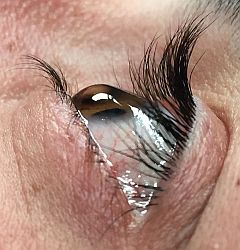(BMJ)—A 27-yo woman presented w/ painful leg lesions, despite 2wk of tx w/ amoxicillin/clavulanate for presumptive bilateral cellulitis. She had started an OCP 3mo prior. Exam: afebrile; tender, red, warm plaques w/ confluent palpable nodules on legs. Labs, UA, and CXR all normal. What is the dx?

|
Calcifying panniculitis
|
|
Nodular vasculitis
|
|
Thrombophlebitis
|
|
Drug-induced erythema nodosum
|
|
Pyoderma gangrenosum
|
(BMJ)—An otherwise healthy 28-yo man presented w/ a 3-yr hx of gradually worsening visual acuity. Visual acuity exam: L eye (uncorrected), 20/100; L eye (corrected), 20/60. Scissoring of red reflex and conical reflection on nasal cornea when penlight shone from temporal side. What is the dx?

|
Fuchs corneal dystrophy
|
|
Terrien marginal corneal degeneration
|
|
Pellucid marginal degeneration
|
|
Keratoglobus
|
|
Keratoconus
|
